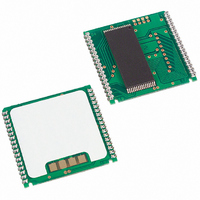DS1553P-100+ Maxim Integrated Products, DS1553P-100+ Datasheet - Page 7

DS1553P-100+
Manufacturer Part Number
DS1553P-100+
Description
IC RTC RAM Y2K 5V 100NS 34-PCM
Manufacturer
Maxim Integrated Products
Type
Clock/Calendar/NVSRAM/Y2Kr
Datasheet
1.DS1553WP-120.pdf
(20 pages)
Specifications of DS1553P-100+
Memory Size
64K (8K x 8)
Time Format
HH:MM:SS (24 hr)
Date Format
YY-MM-DD-dd
Interface
Parallel
Voltage - Supply
4.5 V ~ 5.5 V
Operating Temperature
0°C ~ 70°C
Mounting Type
Surface Mount
Package / Case
34-PowerCap™ Module
Lead Free Status / RoHS Status
Lead free / RoHS Compliant
DS1553 64kB, Nonvolatile, Year-2000-Compliant Timekeeping RAM
READING THE CLOCK
When reading the RTC data, it is recommended to halt updates to the external set of double-buffered RTC
registers. This puts the external registers into a static state, allowing data to be read without register
values changing during the read process. Normal updates to the internal registers continue while in this
state. External updates are halted when a 1 is written into the read bit, B6 of the Control register (1FF8h).
As long as a 1 remains in the Control register read bit, updating is halted. After a halt is issued, the
registers reflect the RTC count (day, date, and time) that was current at the moment the halt command
was issued. Normal updates to the external set of registers resume within 1 second after the read bit is set
to 0 for a minimum of 500s. The read bit must be 0 for a minimum of 500s to ensure the external
registers are updated.
SETTING THE CLOCK
The 8th bit, B7 of the Control register, is the write bit. Setting the write bit to 1, like the read bit, halts
updates to the DS1553 (1FF8h–1FFFh) registers. After setting the write bit to 1, RTC registers can be
loaded with the desired RTC count (day, date, and time) in 24-hour BCD format. Setting the write bit to 0
then transfers the values written to the internal RTC registers and allows normal operation to resume.
CLOCK ACCURACY (DIP MODULE)
The DS1553 is guaranteed to keep time accuracy to within 1 minute per month at +25C. The RTC is
calibrated at the factory by Dallas Semiconductor using nonvolatile tuning elements and does not require
additional calibration. For this reason, methods of field clock calibration are not available and not
necessary. The electrical environment also affects clock accuracy and caution should be taken to place the
RTC in the lowest level EMI section of the PC board layout. For additional information, refer to
Application Note 58: Crystal Considerations with Dallas Real-Time Clocks, available on our website at
www.maxim-ic.com/appnoteindex.com.
CLOCK ACCURACY (PowerCap MODULE)
The DS1553 and DS9034PCX are each individually tested for accuracy. Once mounted together, the
module typically keeps time accuracy to within 1.53 minutes per month (35ppm) at +25°C. The
electrical environment affects clock accuracy and caution should be taken to place the RTC in the lowest
level EMI section of the PC board layout. For additional information, refer to Application Note 58:
available
on
our
website
at
Crystal
Considerations
with
Dallas
Real-Time
Clocks,
www.maxim-ic.com/appnoteindex.com.
FREQUENCY TEST MODE
The DS1553 frequency test mode uses the open-drain
/FT output. With the oscillator running, the
IRQ
/FT output toggles at 512Hz when the FT bit is 1, the Alarm Flag Enable bit (AE) is 0, and the
IRQ
Watchdog Steering bit (WDS) is 1 or the Watchdog register is reset (Register 1FF7h = 00h). The
/FT
IRQ
output and the frequency test mode can be used as a measure of the actual frequency of the 32.768kHz
RTC oscillator. The
/FT pin is an open-drain output that requires a pullup resistor for proper
IRQ
operation. The FT bit is cleared to 0 on power-up.
7 of 20













